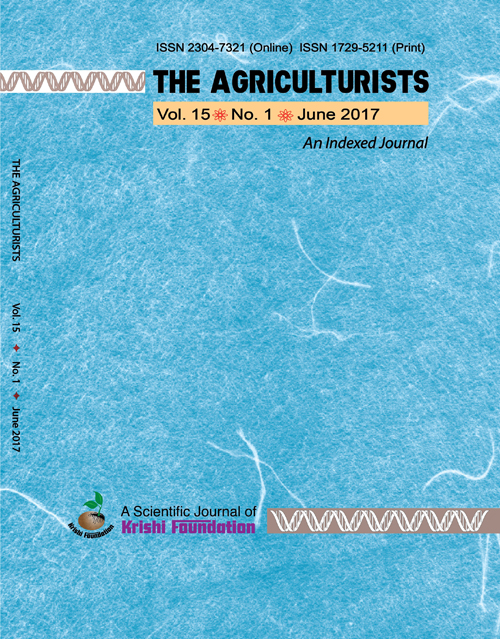Combined Effect of Arbuscular Mycorrhiza, <i>Rhizobium</i> and <i>Sclerotium rolfsii</i> on Grass Pea (<i>Lathyrus sativus</i>)
DOI:
https://doi.org/10.3329/agric.v15i1.33438Keywords:
Single and dual inoculation, diseases, germination percent, nodule number, Lathyrus sativus.Abstract
The present study was carried out to evaluate the combined effect of indigenous arbuscular mycorrhizal (AM) fungi, Rhizobium and Sclerotium rolfsii on Grasspea (Lathyrus sativus) in the net house of Soil Science Division, Bangladesh Agricultural Research Institute, Joydebpur, Gazipur during 2014-2015 through 2015-2016. The experiment was designed in RCBD with 8 treatments and 4 replications. Grasspea variety BARI Khesari-1 was used as a test crop. Peat based rhizobial inoculum (BARI RLs-10) was used in this experiment @ 50 g kg-1 seed. The AM fungi used in this experiment were Glomus fusianum, Glomus macrocarpum, Glomus warcuppi, Acaulospora foveata, Acaulospora denticulate, Gigaspora albida, Gigaspora rosea, Glomus spp. etc. Soil based AM inoculum containing about approximate 252 spores and infected root pieces of the host plant was used pot-1. There were eight treatments viz. T1: Arbuscular mycorrhiza (AM), T2: Rhizobium, T3: AM + Rhizobium, T4: Sclerotium rolfsii, T5: Sclerotium rolfsii + AM, T6: Sclerotium rolfsii + Rhizobium, T7: Sclerotium rolfsii + AM + Rhizobium and T8: Control. Dual inoculation (AM + Rhizobium) significantly increased germination (%), nodule number and dry weight, root colonization by AM fungi and spore population in rhizosphere soils of grasspea compared to single inoculation or any other treatments. Dual inoculation increased germination after 23 DAS (20% in 2014-2015 and 23% in 2015-2016) compared to control. It increased nodule number plant-1 (172% in 2014-2015 and 72% in 2015-2016) over AM treatment, and (112% in 2014-2015 and 26% in 2015-2016) over Rhizobium treatment. It also increased root infection (20% in 2014-2015 and 56% in 2015-2016) over AM treatment, and (200% in 2014-2015 and 100% in 2015-2016) over Rhizobium treatment. It reduced foot and root rot disease (48% in 2014-2015 and 44% in 2015-2016) compared to control. On the contrary, Sclerotium rolfsii + Rhizobium, Sclerotium rolfsii + AM, and Sclerotium rolfsii + AM + Rhizobium reduced 12-17%, 16-20% and 28-31% foot and root rot disease, respectively compared to only Sclerotium rolfsii treatment. Therefore, use of these bio-control agents could be promoted as an active component of bio-intensive Integrated Disease Management Program (IDMP) under organic mode.
The Agriculturists 2017; 15(1) 143-155
Downloads
131
175

